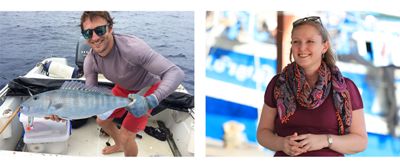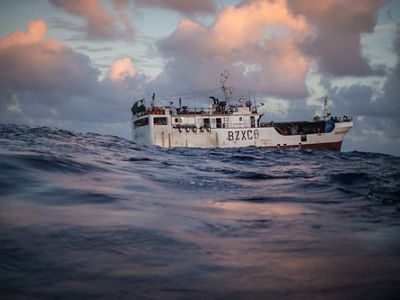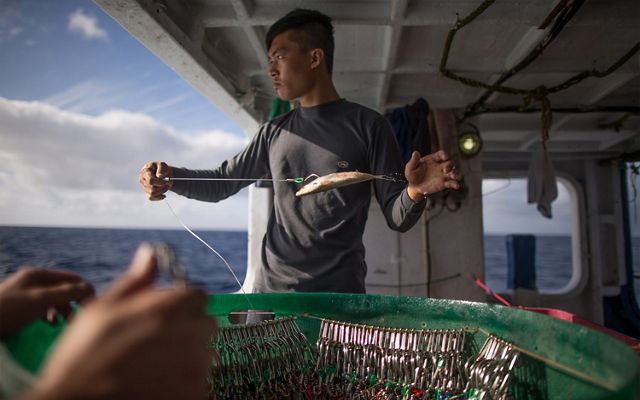Shedding Light on the Sea to Save It
A multi-billion dollar seafood company is working with conservationists to increase tuna transparency—two of their leaders share why.
By Mark Zimring and Darian McBain
So much of what happens at sea remains beyond human comprehension, even as billions of people consider it their main source of food. One thing that’s clear: our ocean, marine species and the fisheries that rely on them are in peril.
That’s why a new commitment from Thai Union (TU), one of the world’s largest seafood companies, is so important. This week, the firm announced it was partnering with The Nature Conservancy (TNC) to raise the standard of tuna transparency worldwide, aiming to implement on-the-water monitoring across its vast supply chain by 2025.
Together with TNC’s sustainable fisheries experts, Thai Union is doing its part to eliminate widespread illegal, unregulated and unreported (IUU) fishing practices from the industry. The new initiative will entail deploying electronic monitoring (EM)—including onboard video cameras, GPS, and sensors to automatically assess activities onboard—or employing human observers on all partner vessels.
Mark Zimring, TNC's lead for large-scale fisheries, and Darian McBain, Thai Union's global head of corporate affairs and sustainability, recently joined us to share how this collaboration emerged, plus what it could mean for the health of the world's fisheries, and the US$159.3 billion seafood industry that relies on them.

What makes this such a game-changing initiative for the tuna industry?
Darian McBain: Our partnership shows not only what TU and TNC can do together, but how we can help shape the industry to be more transparent and sustainable. As our CEO says, "Change takes more than a wish and well-crafted words." We believe we can help define a sustainable path for an industry that desperately needs it, and that’s starts with some transparency about our operations.
Mark Zimring: Exactly. The ocean’s food supply system is not secure and not resilient enough. Too few fisheries are taking enough care to monitor what comes out of the seas. This lack of transparency in the industry makes it nearly impossible for consumers to confidently select a sustainably harvested seafood product. This collaboration is an additional step toward a new industry standard for the entire seafood sector.


Let’s talk about the scale of the challenge. What’s at stake here?
MZ: The health of the world's fisheries are integral to the overall health of the ocean, as well as the well-being of the people who rely on the ocean’s resources. Unsustainable fishing acts as a threat multiplier that reduces ocean resilience—and the ocean is already facing threats ranging from acidification and warming to pollution. Two-thirds of all fisheries are either overfished or can’t sustain any more pressure, even as global protein demand is expected to rise by 70 percent by 2050.
The negative impacts of IUU run deep—from hundreds of millions of dollars in lost revenue for local communities and national governments, to significant levels of “bycatch” of at-risk species such as sharks and sea turtles that put seafood supplier sustainability commitments at risk, to the overfishing of regional tuna stocks—which threatens ecosystems, global food supplies, and the livelihoods of fishers. Not to mention, fishers often face egregious labor abuses in making their living.
Licensed fishing vessels are responsible for more than 90 percent of IUU activity in Pacific tuna fisheries, through practices like misreporting and underreporting of catches—and it’s lack of monitoring that enables that. What’s more, the lack of monitoring coverage creates fundamental data gaps that impede sustainable fishery management and supply chain efficiency.
Talk us through what you're seeing from consumers and demand for more sustainable seafood.
DM: The pandemic has piqued consumers’ interest in food—where it’s from, how it was produced, and whether it is healthy. People have started to think about global supply chains like never before, asking questions about sourcing in new and thoughtful ways. The industry is seeing a more conscientious consumer base driving direct-to-consumer sales and subscriptions, thanks in part to tools such as the Marine Stewardship Council's certification. Using technology like electronic monitoring throughout our global tuna supply chain can increase that transparency, as well as enable earlier interventions on the water when needed. Opaque supply chains are so 2019!
Quote: Darian McBain

People have started to think about global supply chains like never before, asking questions about sourcing in new and thoughtful ways.
And yet we still don't have much transparency—why not, and what are the consequences?
MZ: It's important to first understand what the open ocean fisheries look like in reality. In the Western and Central Pacific Ocean, an area roughly the size of North America, thousands of vessels drop about a billion hooks per year into the region’s productive waters. In these waters, fishers catch more than 2/3 of the planet’s annual tuna harvest, and less than 5 percent of these vessels have independent on-board monitoring.
It's no wonder they often refer to large-scale, open-ocean fisheries as the "wild, wild wet," because the size of these fisheries is massive and we have very little visibility into what’s happening out on the water. This has unfortunately resulted in widespread IUU fishing practices, and in some cases, human rights abuses.
But, let’s be clear. There are good guys out there too, trying to do the right thing, recognizing their catch has ramifications beyond their boat. And now, technology solutions can disrupt the industry status quo. Through electronic monitoring, we could have eyes on every vessel, providing a helpful check on bad actors and providing validation and credibility for those who are playing by the rules and working to provide a sustainable food option.
That's why a collaboration of this scale has the potential to be a game changer for the industry, and why we are so eager to engage. EM tools offer actionable data that will help reduce poaching, make fisheries more sustainable—and stabilize the ocean ecosystem.
So what is electronic monitoring, and how can it get us to more transparency?
MZ: Electronic monitoring (EM) is the use of onboard video cameras, GPS and sensors to automatically track catch onboard fishing vessels. Instead of relying on a single human observer to write down notes about what species are caught and when, EM cameras automatically record all fishing activity 24/7 while a vessel is at sea—including GPS location tagging.
It’s beneficial for a few reasons: data doesn't get sick, it doesn't need a vacation, and its life isn't at risk if it tells the truth—which is not always the case for human monitors, unfortunately.
Our global insights, straight to your inbox
Get our latest research, insights and solutions to today’s sustainability challenges.
Sign UpWhat happens next? What does your partnership look like?
MZ: Thai Union is one of the largest producers of shelf-stable tuna products, with annual sales exceeding $4.1 billion. The sheer magnitude of this company makes this is a major milestone when it comes to ocean conservation.
DM: And it’s not just tuna we want to improve. In addition to monitoring of our vast tuna supply chain in international waters, we are also committing to driving change and the monitoring of our European wild-caught sprat, mackerel, herring and whiting supply chains—all by 2025.
For us, it’s about advancing our “SeaChange” commitment—changing seafood for good. Together with TNC, we plan to increase the pressure for change on the rest of the industry by jointly engaging with governments, regulators, and supply chain actors to drive progress toward transparency. TNC’s expertise will be invaluable to bringing about greater transparency in the seafood industry, and really scaling up that change beyond just one company.
MZ: That’s right. Thai Union is the first to step up here. Now we need other industry actors, including retailers, to make firm commitments and require this transparency in the supply chain. We believe this will be a tipping point for the industry.
In fact, the TU commitment is complemented by ongoing work supported by the Walmart Foundation to scale EM to every vessel, making practices on the water transparent. We are working with academic and NGO partners to scale a uniform EM solution that can be cost effective for the industry and easily adapted across fisheries.
Let's be honest, the fishing sector has a pretty dodgy history. Why should a conservation organization work in such close partnership with this industry?
MZ: TNC believes strongly in scaling conservation solutions that are both effective for the planet and good for people in order to drive market-based—and therefore, durable—change. It's important to mention, too, that food producers are increasingly recognizing environmental risks as material operational risk. Gone are the days where companies make “corporate social responsibility” announcements; now, sustainability is seen as a matter of true self-preservation. By helping to get this industry application right, we believe we can substantially improve ocean health and better support communities that rely on it for their livelihoods.
DM: There is a lot of criticism of the seafood industry, and we welcome the role NGOs like TNC are playing—stepping up to the plate and serving as both agitator and pragmatic partner.
To be a critical friend, as the best NGO partners are, you need to be willing to rock the boat (pun intended!) and raise significant issues of concern, but also be there to work through and implement the potential solutions. And I believe that is what TU has found in TNC.
Global Insights
Check out our latest thinking and real-world solutions to some of the most complex challenges facing people and the planet today.



